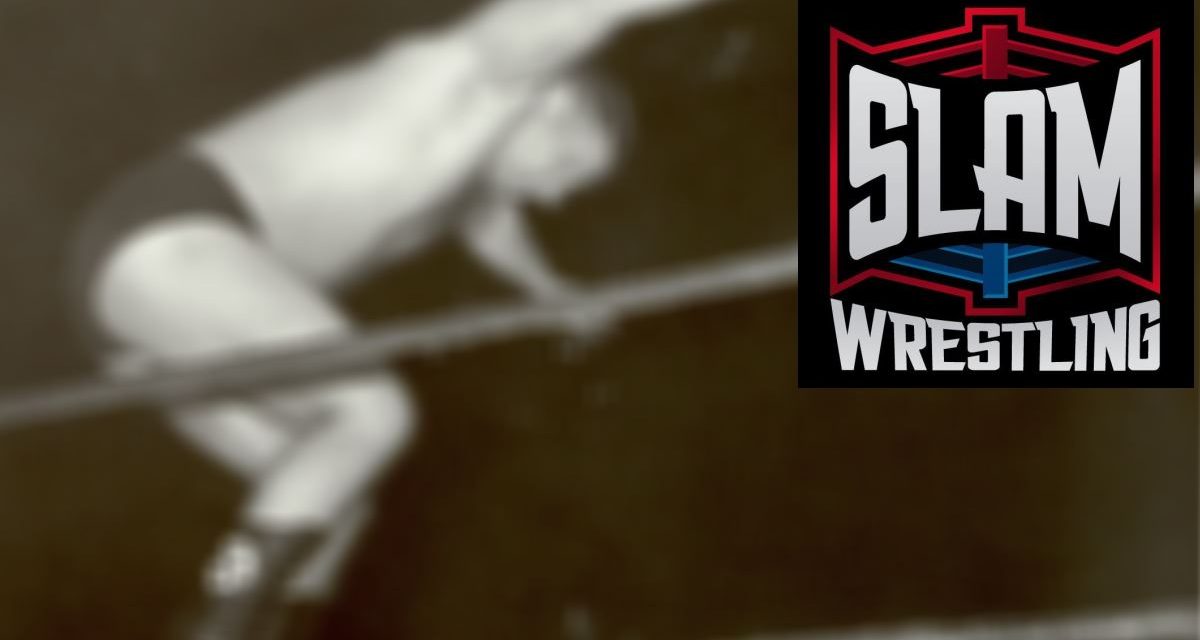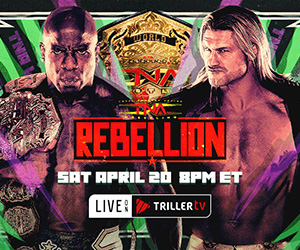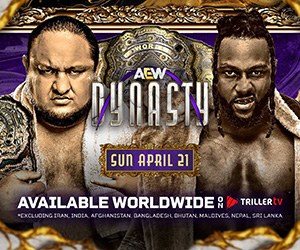Whereas the phrase “Kung Fu” was somewhat known in North America in the early 1970s on the back of the hit David Carradine TV show, when it came to the United Kingdom in the same period, it was far from a household term.
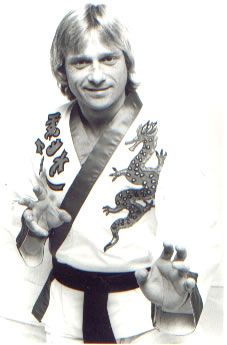
“Kung Fu” Eddie Hamill. Photos courtesy www.theamazingkungfu.co.uk
Remarkably, one of the men who popularized the phrase in the UK was Eddie Hamill, a professional wrestler originally from Northern Ireland, who used a martial arts gimmick in arenas up and down the country, and on television.
“I’d been wrestling for just a few years, when I realized that I needed a gimmick to go farther in the business,” Hamill told SLAM! Wrestling. “I thought of the name ‘Kung Fu’, as that phrase was just beginning to get very popular here, following the Bruce Lee films. Also, I had done some martial arts, and would incorporate them into my bouts. I added a mask for an extra bit of mystery, and it all seemed to fit into place.”
Indeed, the character — which was debuted in 1971 — was an instant hit with the British fans, who had never seen anything quite like it before. Some of Hamill’s fellow wrestlers, however, weren’t so enthralled with the non-traditionalist gimmick.
“I remember when I worked with the mask, Mark Rocco came up to me in the dressing room,” laughed Hamill. “He told me, ‘Listen Eddie, this mask isn’t a good idea. Everyone that wears a mask is a villain, and you’re trying to be a blue-eye (babyface).’
“I said, ‘Mark, I don’t agree with you. Batman wears a mask, Spider-Man wears a mask, The Lone Ranger wears a mask — do you want me to go on?’ And he just turned round to me and said ‘Well, I don’t think it’s a good idea!’ Of course, Rocco was right in the sense that people assumed you were a villain if you wore the mask, but I switched them with my work in the ring.”
Kung Fu’s unique brand of wrestling came to be loved by many wrestling fans, but growing up in Belfast in the 1940s and ’50s, a career as a wrestler wasn’t something that Hamill had even conceived of. But he was interested in one-on-one contact sports, which indirectly led him to the profession that made him famous.
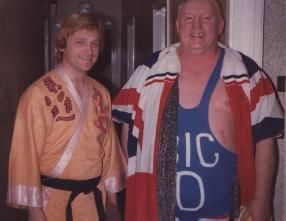
Eddie Hamill and Big Daddy in 1978.
“I was never interested in regular sports like rugby or football,” he said. “But I did go to Smithfield market in Belfast one time, and buy myself a book called Teach Yourself Judo. My brother and a friend of mine used to go into the back garden and try out all these things in the book. But you couldn’t learn everything from just that, so when a YMCA judo club opened nearby, that’s where I went. I continued going there until I started wrestling.”
Transitioning from judo, then, the then 20-year-old first cut his teeth in wrestling much like countryman Dave Finlay, Sr., by attending “The Pit” wrestling club on Albion Street in the capital. Hamill had only ever seen live wrestling once, but when he spotted an advert in the Belfast Telegraph newspaper, he was excited to give a new sport a go.
“When I saw the ad, the first thing I did was go to a friend of mine, who also went to the judo club, and said ‘Do you want to be a professional wrestler?!’ So we both went to this gym that was like a big shed, with a ring in it, and horrible, old walls and equipment.
“Noel Arnott trained both myself and Dave Finlay (Snr). Immediately, he noticed that I could take a fall, which I could because I’d learned to do it in judo. So I progressed a little quicker than the others, but it wasn’t until I couldn’t learn much more there, that he finally let me in one of the most important bits — that the wrestling business was bent. Up to that point, we’d been hammering each other, thinking it was real, but his words were that ‘we try to look after each other’. I suppose that’s a good way of describing what professional wrestlers do.”
“There’s no doubt in my mind that Eddie Hamill was one of the very best,” said Dave Finlay Sr. “Between he with his judo background, and me with a gymnastics background, we dreamt up moves that people have never seen before. I remember wrestling him in the Queen’s Hall in Newtownards (just outside of Belfast), and the local paper wrote an article saying how absurd it was that we weren’t wrestling on television. Mind you, we were knocking ten bells out of each other!”
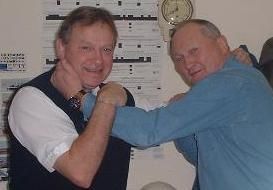
Eddie Hamill and Johnny Palance in 2004.
It took Hamill around a year before he was designated to be ready for his first match, a tag team contest against the Kydd Brothers. At the time, he was billed as Mike “Judo” Hamill, a nod to his father, who worked in Belfast’s famous shipyards, during a time of religious tension in the Province.
“My father’s name was Francis Hamill, and simply because of that, everyone in his workplace thought that he was a Catholic. So he got the nickname Mickey (a somewhat derogatory term for a Catholic person), and I changed it around to ‘Mike’. So the name really came from my father, and I used it until I opted for Kung Fu.”
After working the Northern Ireland circuit in towns such as Cookstown, Armagh, and Londonderry, Hamill made his first foray to the UK mainland in 1969, to work for Welsh promoter Oric Williams. Two years later, he made the decision to move away from Northern Ireland, though wrestling wasn’t the only factor in reaching the conclusion to do so.
“The troubles in Northern Ireland were a big factor in the decision,” noted Hamill. “When Oric offered me work in Wales, I told my wife and son that we were moving, and so we just packed up and left.”
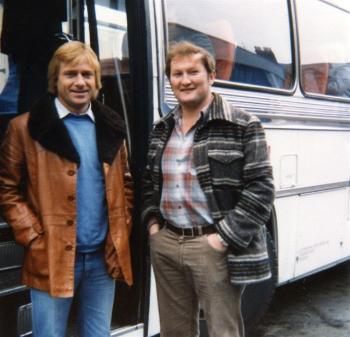
Eddie Hamill and Johnny Palance on their way to wrestle in Canada.
While Hamill initially wrestled for Williams, he eventually began taking dates with another promoter, Brian Dixon, as well as Joint Promotions, famous for their Saturday afternoon television institution, known as World of Sport. He wrestled in front of the nation’s eyes on dozens of different occasions, at times with viewerships in the region of 10 million (astonishingly, a little less than one fifth of the population). No matter whether on TV or on a house show, however, there was always one opponent in particular that Hamill relished lining up across the ring from.
“Out of all the guys that I faced at the time, I think my favourite bouts were with Mark Rocco,” he recalled. “We had some great matches all over the country. I remember a gimmick we did one time, with an old watch of mine that was broken. Max (Crabtree, the promoter) wanted me to do an angle with Rocco, where I’d challenge him after his match. So I told Max, ‘Leave it to me, I have an idea’, and I let Rocco in on what I was going to do.
“So, he was in the ring after his match, and I’d had mine earlier on in the card. I got into the ring in my regular clothes and challenged him, taking off my watch — the broken one — and handing it to the referee, like I was getting ready to fight. But Rocco ran over, grabbed the watch from the referee, and smashed it on the ringpost, sending bits flying everywhere. I shouted, ‘No! That was an anniversary present!”, and so he got incredible heat for that.
“It was such a simple thing for that level of heat, and, of course, that meant we could have a return match the following week. But to show you how over a little idea got, when we came back for my revenge on Rocco, the audience had clubbed together and bought me a new watch! That’s God’s honest truth.”
Along with the reputation for being a world-class junior heavyweight — a cause he furthered in Japan as Tiger Mask’s nemesis, Black Tiger — Rocco was also known for his boundless energy and aggression, which routinely made the bouts between he and Hamill show-stealers. The hard style suited “Kung Fu” just fine.
“Rocco was completely hyperactive, in and out of the ring. If you were walking down the road with him, he’d be knocking you up and down the street. He was like that — and in the ring, too. He was never off you, and you always came out of a match with Mark with a black eye or something. But truth be told, I liked it that way, because I wanted it to look real. In the ring, he was my perfect partner.”
The year 1976 was one of change for Hamill, and indeed the Kung Fu character, as it was decided that he would wrestle without the mask. The change was one that Hamill felt was forced somewhat upon him, but not, as you might expect, by the promoter.
“There was one occasion in particular that I was wrestling in Liverpool stadium, and the people were actually shouting, ‘That’s not Kung Fu.’ I was aware that there were four people who were working purporting to be me, but I felt what happened in Liverpool was just ridiculous. Mick McManus, who ran the towns in the south for Joint Promotions, asked me if I wanted to drop the mask. So on television, it was said that I would have to unmask if I lost, and he beat me in April of that year.”
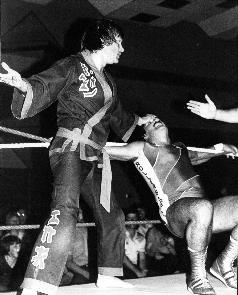
Kung Fu Hamill versus Mark “Rollerball” Rocco.
The change only served to make the character more popular with British crowds, but just a few years later, in 1981, the mask was to come out of storage for another run, this time in Canada, with Stampede Wrestling. Frank “Chic” Cullen was the go-between, since he was working in the territory at the time.
“I got the call from Frank one day, saying that Stampede would like me to wrestle for them, but with the mask. So I did a three-month tour there (beginning in October 1981), and was then asked back for a second. I wasn’t going to do it, as I had a wife and children at home, but when it was suggested that they could come with me, I thought better of it and accepted.”
Hamill spent much of his time in Canada wrestling opponents such as Mike Hammer, Jude Rosenbloom, and the legendary Dynamite Kid — whom, incidentally, he never wrestled on British shores. It took a while for his North American opponents to get used to his unorthodox style, but when they did, it made for many fine contests.
“Eddie Hamill was a very good hand, like so many of the British boys down the years,” said Stampede Saskatchewan promoter and photographer Bob Leonard. “He turned in polished work in the ring, and when the other guys here tuned into what he was doing, he had some nice matches around the territory. He was a nice chap, too.”
“Had he been given a chance, I’m convinced that Eddie could have been a big star in North America,” said Finlay Sr. “He could work with anyone and make them look good. Even through the mask, he had excellent presence, and the charisma to make it. On top of all that, he was the kind of guy who would go out of his way to help the younger talent. If the promoters had had any sense, they would have used him as a tool to help others learn how to have a great match.”
Despite the appreciation of his work, Hamill wasn’t always as delighted to be wrestling in Canada, as Canada was to watch him perform. In no way was that down to the fans, or even the other wrestlers. Instead, it was more due to his frustration with the Stampede promotion itself.
“The Harts were dreadfully disorganized, which was something I wasn’t used to in England,” said Hamill. “For example, there would be times where we would arrive at the arena, and there was no ring. Fans would start to arrive before the show, and be staring into an empty space where the ring was suppose to be.
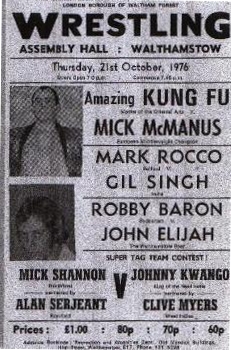
A card in 1976.
“I also recall things like going to the ring for my match, and having the wrong person come out to face me. The other guy would get in the ring, and would then have to leave again because that wasn’t what was booked. The public would never have accepted that in England, and I couldn’t accept it either.”
After two tours of the Canadian circuit, then, Hamill opted to return home with his family, to go back to Joint Promotions. Soon, however, he left that company to return to work for Dixon and Williams once again. He was one of many of the Joint Promotions stars that jumped ship, recognizing that there were better opportunities elsewhere.
“I left simply because I was able to make more money with Brian and Oric,” said Hamill. “With Joint Promotions, you’d only make £60 to work on television, but if you wrestled in the Royal Albert Hall, with no TV, you’d make £100. There were several of us that moved, like Les Kellett, Adrian Street, and Kendo Nagasaki. With that, I was working six days a week, and earning good money for the time.”
It was towards the end of the ’80s, with British wrestling on a huge decline (due to the actions of television chief Greg Dyke, who had a strong distaste for wrestling), that Hamill began to realize that his time as a professional wrestler was almost done. An accumulation of injuries began to take their toll, and with a vehement pride in his performances, he wanted to make sure that he left the business, before he had nothing else to offer it.
“I realized I was getting to the stage where I couldn’t go anymore — the flair had gone. I wasn’t doing the same things, and I began to worry about injuries. The fact of the matter was that I couldn’t recover from injuries as quickly as before, and if I got hurt, that would be me out of work until I recovered. The thought of that really affected me, and when a job as a lifesaver for the Lifeboat Institution in Rhyl (in Wales) came up, I took it.”
Hamill would still perform what British wrestlers knew as “after tea jobs” — an evening show close to home, where you could arrive into the arena, do your match, and get away quickly. But over time, recognizing that it wasn’t the same, he began to turn away offers to do those as well.
Today, Eddie Hamill is newly retired from his work as a lifesaver — though he is still active with the group on a voluntary basis — and has avoided the temptation to step into the squared circle once again, unlike several of his peers, most notably Johnny Saint and Kendo Nagasaki, two men who are also in their 60s.
“Sometimes I’ll get a call from my daughter that I’m on a TV re-run, and occasionally I will sit down and watch. Sometimes I feel sorry that I did, other times I’m pleased with the match. I wouldn’t even contemplate wrestling today. With all the injuries I’ve had, it’s just out of the question.”
Indeed, Hamill contents himself as a part of his new team in the Lifeboat Institution, and with attending the various British wrestling reunions, held annually in England. That way, he gets to keep involved in the part of the business that he loved the most — having a laugh with the boys.
“There was always something going on in that dressing room — someone telling jokes or playing tricks. It was all fun. And when we get together at the reunions, we talk about those good times, and all those things we did.
“These days, with the work with the lifeguards, I’ve got a different team around me, but in sort of the same way, we can have a joke and a laugh, too. They’re engrossed with lifesaving, in the way I was with my wrestling. I guess I miss the in-ring stuff a little, but I miss the dressing-room camaraderie and fun with the other wrestlers even more so than that.”
